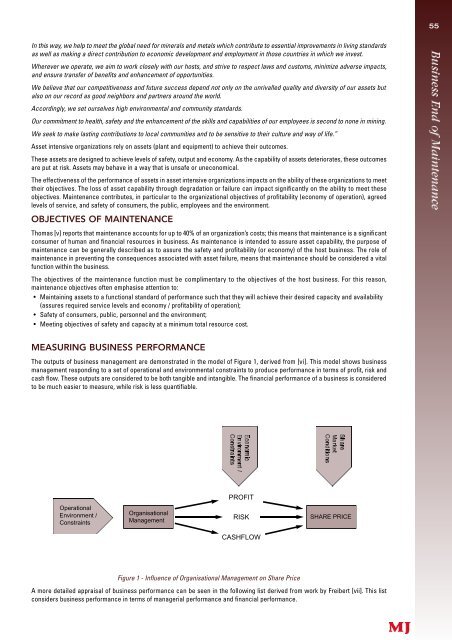October - Library - Central Queensland University
October - Library - Central Queensland University
October - Library - Central Queensland University
You also want an ePaper? Increase the reach of your titles
YUMPU automatically turns print PDFs into web optimized ePapers that Google loves.
In this way, we help to meet the global need for minerals and metals which contribute to essential improvements in living standard s<br />
as well as making a direct contribution to economic development and employment in those countries in which we invest.<br />
Wherever we operate, we aim to work closely with our hosts, and strive to respect laws and customs, minimize adverse impacts,<br />
and ensure transfer of benefits and enhancement of opportunities.<br />
We believe that our competitiveness and future success depend not only on the unrivalled quality and diversity of our assets but<br />
also on our record as good neighbors and partners around the world.<br />
Accordingly, we set ourselves high environmental and community standards.<br />
Our commitment to health, safety and the enhancement of the skills and capabilities of our employees is second to none in mining.<br />
We seek to make lasting contributions to local communities and to be sensitive to their culture and way of life.”<br />
Asset intensive organizations rely on assets (plant and equipment) to achieve their outcomes.<br />
These assets are designed to achieve levels of safety, output and economy. As the capability of assets deteriorates, these outcomes<br />
are put at risk. Assets may behave in a way that is unsafe or uneconomical.<br />
The effectiveness of the perf o rmance of assets in asset intensive organizations impacts on the ability of these organizations to meet<br />
their objectives. The loss of asset capability through degradation or failure can impact significantly on the ability to meet these<br />
objectives. Maintenance contributes, in particular to the organizational objectives of profitability (economy of operation), agre e d<br />
levels of service, and safety of consumers, the public, employees and the environment.<br />
OBJECTIVES OF MAINTENANCE<br />
Thomas [v] re p o rts that maintenance accounts for up to 40% of an org a n i z a t i o n ’s costs; this means that maintenance is a significant<br />
consumer of human and financial re s o u rces in business. As maintenance is intended to assure asset capability, the purpose of<br />
maintenance can be generally described as to assure the safety and profitability (or economy) of the host business. The role of<br />
maintenance in preventing the consequences associated with asset failure, means that maintenance should be considered a vital<br />
function within the business.<br />
The objectives of the maintenance function must be complimentary to the objectives of the host business. For this re a s o n ,<br />
maintenance objectives often emphasise attention to:<br />
• Maintaining assets to a functional standard of performance such that they will achieve their desired capacity and availability<br />
(assures required service levels and economy / profitability of operation);<br />
• Safety of consumers, public, personnel and the environment;<br />
• Meeting objectives of safety and capacity at a minimum total resource cost.<br />
MEASURING BUSINESS PERFORMANCE<br />
The outputs of business management are demonstrated in the model of Figure 1, derived from [vi]. This model shows business<br />
management responding to a set of operational and environmental constraints to produce performance in terms of profit, risk and<br />
cash flow. These outputs are considered to be both tangible and intangible. The financial performance of a business is considered<br />
to be much easier to measure, while risk is less quantifiable.<br />
Operational<br />
Environment /<br />
Constraints<br />
Organisational<br />
Management<br />
PROFIT<br />
Figure 1 - Influence of Organisational Management on Share Price<br />
SHARE PRICE<br />
A more detailed appraisal of business perf o rmance can be seen in the following list derived from work by Fre i b e rt [vii]. This list<br />
considers business performance in terms of managerial performance and financial performance.<br />
RISK<br />
CASHFLOW<br />
55
















